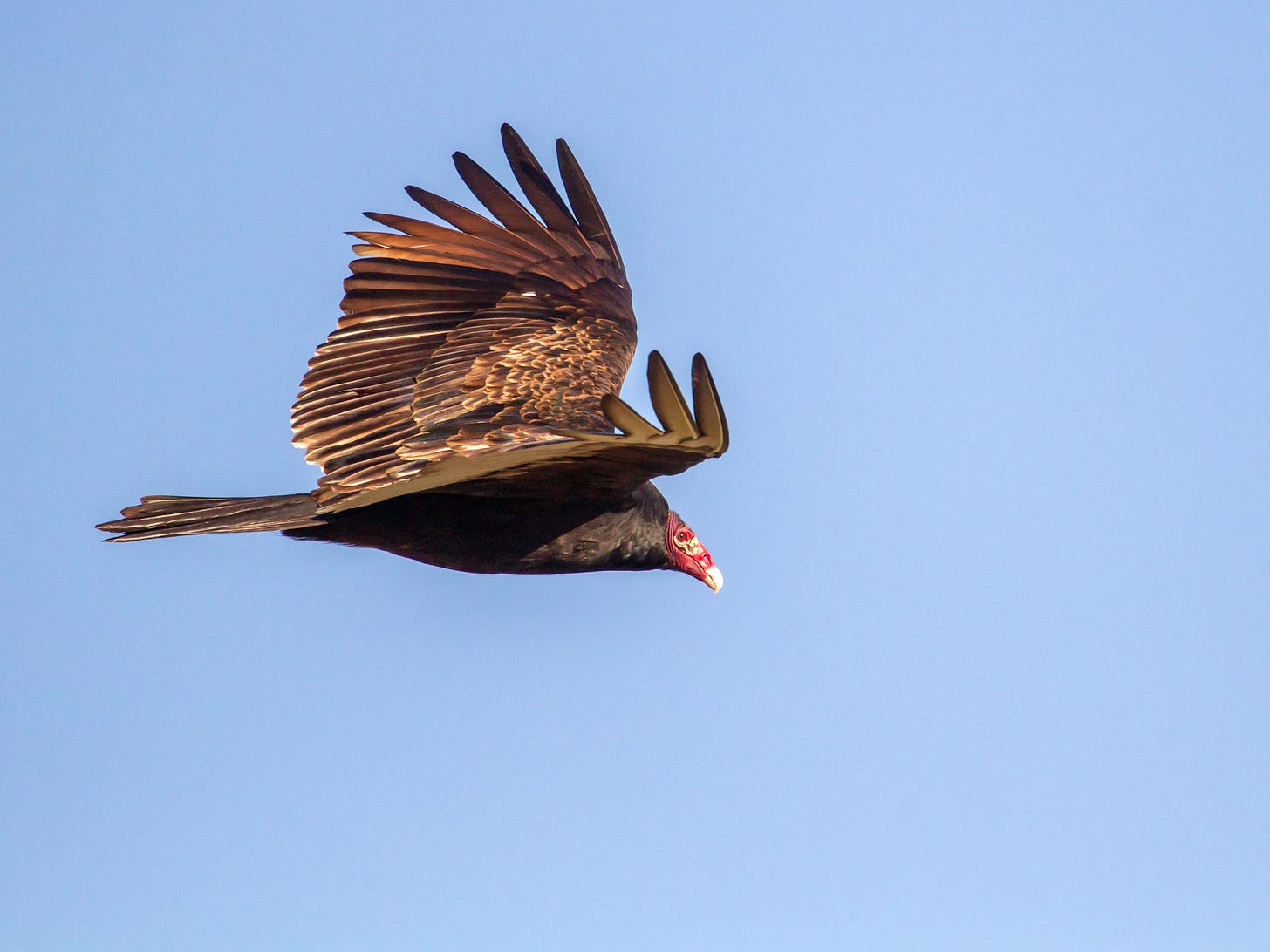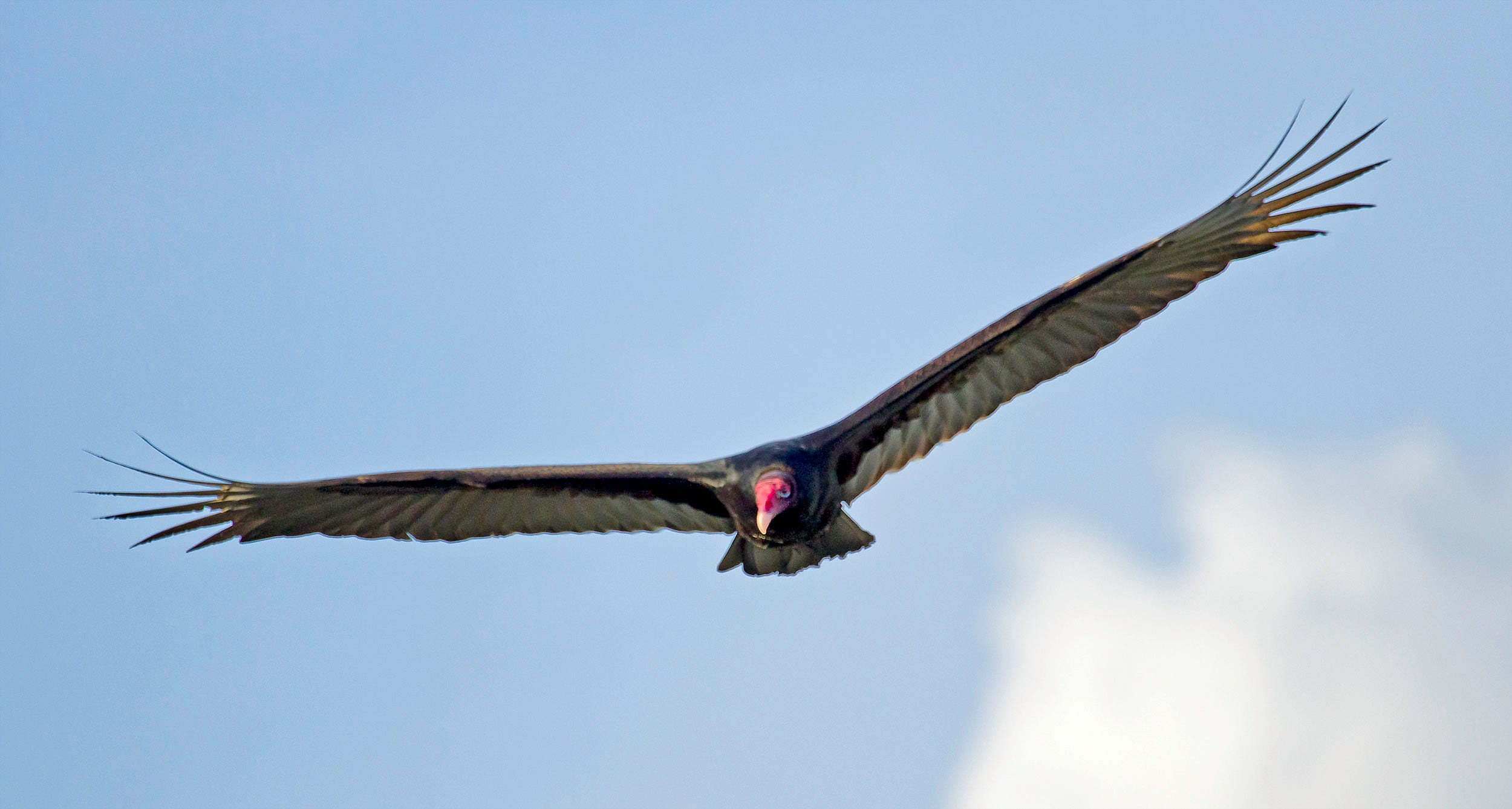Vultures and the Culture Wars
A symbol for a nation as carrion? Or a rightful and imperfect sign of spring?
FROM WHERE I NOW SIT south of the Mason-Dixon line, I have breaking news for my fellow northerners: the vultures are coming for us.
I mean that literally. Actual vultures — Turkey Vultures — are flying north as imperfect harbingers of spring.
From my home in Vermont, I’m now on a road trip into the southeastern United States to meet the spring in all its manifestations: warmth, wildflowers, butterflies, songbirds, baseball.
By the time I reached Philadelphia in late February, the Red Maples were already blooming along I-95. At a roadside rest area in North Carolina, the season’s first butterflies were on the wing. And throughout my route, it has been Turkey Vultures all the way down. They drift at low altitude, holding their wings in a slight dihedral and teetering gently from side to side, their naked, ruddy heads seeking out the dead.
For at least 50 years Turkey Vultures have been expanding their range and numbers into New England, other northern states, and portions southern Canada. We’re not entirely sure why, but more roads and more vehicles, and therefore more roadkill, might explain part of it. A warmer planet is probably another reason.
Whatever the case, I’m okay with more vultures, which have some unusual and wonderful adaptations compared with other birds. One is an acute sense of smell, which allows them to find carrion otherwise hidden in the woods. We suspect vulture pairs remain monogamous and mate for life, unlike lots of other birds. And vultures reportedly defend themselves from predators by vomiting at will (not that any of us would care to test this).
One morning, while birdwatching in North Carolina, I ended up chatting for nearly an hour with an 80-year-old marine veteran who had seen a lot of the world. He told me that the Ospreys would return here any day to nest (they did), and I pointed out an Orange-crowned Warbler feeding near us in a Yaupon Holly (which I kid you not goes by the scientific name Ilex vomitoria). We discussed military corruption and the horrors of warfare. And we talked about kids and families, getting old, and marriages that didn’t last.
When it was time for breakfast, we smiled and bid each other well. As I walked a park road toward my campsite, he passed me with a wave and a toot from his beater blue-and-white Chevy pickup sporting a Trump-Pence bumper sticker on its back windshield.
Had my own contrary politics come up during our conversation, I suspect it wouldn’t have mattered much. Not that I’m naive about the coarseness of our culture and public discourse or the dismal fate of nature. On this roadtrip, on the radio, on billboards and on bumper stickers, it is hard to escape the culture wars and our dysfunctional politics.
So it might be easy for me to see the Turkey Vultures as symbols circling over a nation in decline, a planet dying. The human experiment all too often seems to be going so wrong.
Even so, the Red Maples bloom in red states as well. Spring is coming to the north. It’s the only spring we’ve got. And it’s hard to argue politics when warblers and Ospreys are on the wing. Or even vultures.

A version of this essay first appeared in print on March 19 in The Boston Globe Ideas section, where I’m a regular contributor.
Postscripts
Turkey Vultures overwinter in low numbers in southern New England, but the surge north in March is among our most visible early signs of spring migration. Black Vultures, which generally range farther south in the U.S. than Turkey Vultures, are turning up in greater numbers farther north as well.
More on Turkey Vultures from the Cornell Lab of Ornithology.





I’ve been keeping track of the first sighting of Turkey Vultures and Red-Winged Blackbirds here in South Burlington, VT. Over the past ten years they both show up between March 3rd and 24th—this year on the 8th (TV) and the 6th (RWBB). The first Robin used to make my heart leap with joy but they are now here year-round. Now my heart leaps when I hear “conkaree” and see the TVs soaring. Your two TV pictures are awesome—even to the spark of light in the eye. Thank, Bryan.
As a gal who was born and grew up in Brooklyn, NY, I knew only a little about Nature. Then I married my husband of almost 54 years and came to see the Living Reality all around us. He carries within himself the archetype of the Divine Nature Child - more ‘at home’ in the woods - surrounded by Nature’s Mysteries.
Bryan, I suspect that you too carry the Divine Nature Child in your archetypal panoply. You’re writing draws me in; I can ‘see’ what you’re seeing - what you’re experiencing. What a gift! Thank you for sharing your wanderings and wonderings with us. They caste soft, radiant, reflective Light on a harsh, divisive world. Bless you!